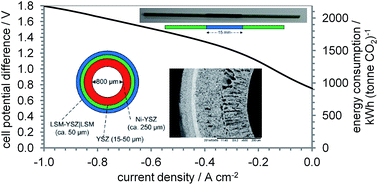Micro-tubular solid oxide electrolysers for electrochemical CO2 reduction of the form Ni–YSZ|YSZ|YSZ–LSM|LSM have been fabricated using a two-step method: dual layer co-extrusion phase inversion to produce electrode-supported| electrolyte precursors and subsequent coating with the outer electrode, whereby each step was followed by (co-)sintering. The microstructures and physical properties of the fibres were characterized and the electrochemical performance of the fabricated electrolysers determined. Electrolyte thicknesses of 19 (±2), 26 (±2) and 49 (±3) μm were achieved. Electrolysis performance increased with increasing temperature (700–800 °C) and with decreasing electrolyte thickness. The maximum performance achieved was 1.0 A cm−2 at 1.8 V cell potential difference at 800 °C for a 15 μm electrolyte. Electrical impedance spectroscopy revealed that only 5–28% of the ohmic polarization resistance was due to the electrolyte resistance; most of the resistance was due to electrical connections and contact potential losses. The feasibility to operate the solid oxide cells in electrolysis and fuel cell modes was demonstrated, revealing that no unique gas composition existed that would optimise the performance in both modes simultaneously.

